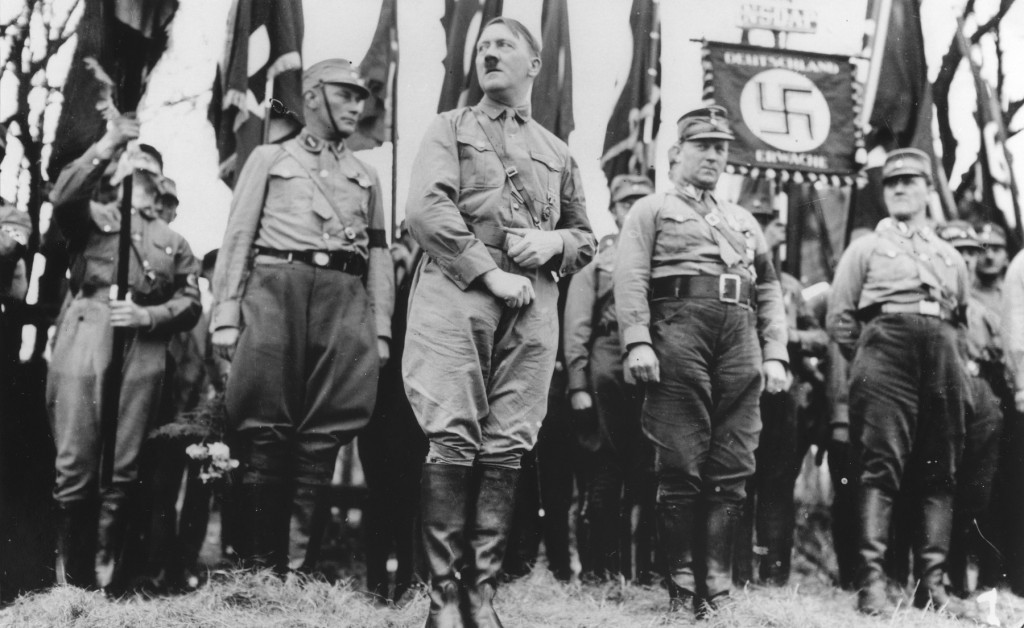
The SA
The Sturmabteilung, or SA, was a paramilitary organization associated with the Nazi Party. The SA was integral to the rise of Adolf Hitler and the Nazi Party, violently enforcing party norms and attempting to influence elections. After Hitler purged the SA during the Night of the Long Knives in 1934, the SA lost most of its power to the Schutzstaffel, or SS, although the SA did not disband until the war ended in 1945.
Key Facts
-
1
The Sturmabteilung, or SA, was also known as the Storm Troopers and the Brownshirts, for the color of their uniform.
-
2
Officially founded in 1921, the SA grew out of the Freikorps groups in Germany at the end of World War I. The SA was a critical component of Hitler’s rise to power, and eventually counted more than 4 million members.
-
3
The 1934 SA purge, known as the Night of the Long Knives, effectively ended the SA’s political and military power.
Origins
World War I ended in 1918 when Germany surrendered to the Allied powers. In the aftermath of the war, Freikorps, or independent paramilitary units, proliferated across Germany. Composed primarily of World War I veterans returning from the war, the Freikorps fought against communists and other groups the Freikorps believed were responsible for German defeat. By 1921, approximately 400,000 men were involved in paramilitary groups. One of these groups was the Turn-und Sportabteilung (Gymnastics and Sports Division) in Bavaria, which was later renamed the Sturmabteilung, or SA.
The SA was associated with the German Workers’ Party (Deutsche Arbeiterpartei), which in turn was renamed the National Socialist German Workers’ Party (Nationalsozialistiche Deutsche Arbeiterpartei), better known as the Nazis. The SA was to provide military protection for the party, while also advancing Nazi ideology. In August 1921, the party’s newspaper, Der Völkische Beobachter, published an open call for young men to join the SA, imploring men to join the fight against “foreign races” bent on destroying Germany.
Founding
In March 1923, Hermann Göring became the leader of the SA, which then had about 3,000 members, primarily in and around Munich. The SA’s primary responsibilities were to serve as Adolf Hitler’s security detail, provide military support to enforce Hitler’s orders, and prevent the functioning of opposing parties, by whatever means necessary. One of the SA’s first organized activities was the Munich Beer Hall putsch on November 9, 1923. The putsch was an attempted coup in which Hitler attempted to seize control of the Bavarian government. The putsch failed, and the SA members who died became revered as “martyrs” in party mythology.
After the putsch, the German government arrested Hitler and banned NSDAP organizations, leading to the formal dissolution of the SA. While Hitler was imprisoned and Göring in exile, Ernst Röhm continued organizing paramilitaries. Röhm attempted to join multiple sympathetic paramilitaries from across Germany under an umbrella organization known as the Frontbann. Röhm later became chief of staff of the SA in 1931.

After Hitler was released from jail, the SA was formally reestablished in February 1925. In 1926, 6,000 Storm Troopers participated in the Nazi Party rally in Weimar. By 1930, however, the SA had grown to 60,000 members. With the devastating economic effects of the Great Depression, the SA grew quickly, reaching 77,000 members by January 1931; 221,000 by November 1931; 445,000 by August 1932; and 4 million by April 1934, once Hitler was in power.
Violence and Purge
As the SA grew, the organization continued to embrace violence. Storm Troopers aggressively interfered with the meetings of opposing political parties, fought in the streets with other paramilitaries, influenced elections, and intimidated Jews, Roma, Communists, and Social Democrats—groups they believed were “enemies of Germany.” For example, in March 1933 brownshirts in Königsburg ransacked the office of local Social Democrats, beat one of the Social Democrats to death, and then used the office as a torture location. In Wuppertal, eight SA members accosted an ex-bandleader of a Communist music group as he walked home one night, fatally shooting him.
Under Ernst Röhm, the SA not only grew, but also became much better organized. Once Hitler came to power, Röhm’s plan was for the Sturmabteilung to absorb and replace the German military. Rohm was an ideologically committed Nazi whose Nazism was motivated more by ideological discipline than personal devotion to Hitler. Once Hitler became chancellor in January 1933, the strength, size, and brutality of the SA, especially under Röhm’s ideological leadership, meant the SA became a potential vulnerability within the fledgling Nazi state and posed a challenge to Hitler’s consolidation of power. Even after the Nazi seizure of power, SA violence continued across Germany. In an event known as the “Köpenick blood-week” in June 1933, a confrontation between Social Democrats and the SA led to the shooting deaths of three Storm Troopers. In response, the SA arrested and tortured more than 500 men; 91 died.
The SA’s capacity to wield violence on this scale, coupled with Röhm’s talk of a “second revolution” to entrench National Socialism, led Hitler to view the SA as an internal threat that was no longer necessary. Therefore, Hitler and his top advisors orchestrated a purge of the SA in 1934, known as the Night of the Long Knives. Röhm was murdered and the independence of the SA curbed. While the SA continued to exist in a reduced capacity until the end of the war, the Night of the Long Knives enabled the SS to move to the front of Nazi policing and security efforts.
Critical Thinking Questions
- Research what pressures and motivations might have influenced members of the SA.
- How can knowledge of the events in Germany and Europe before the Nazis came to power help citizens today respond to threats of genocide and mass atrocity in the world?

